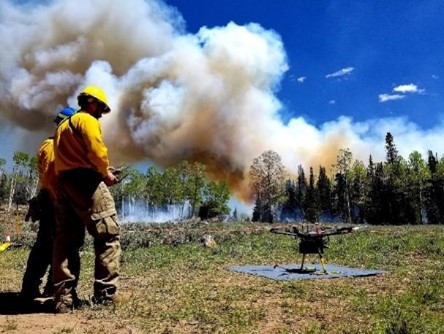From Wildfire Smoke to PFAS: Innovative EPA Scientists Address Longstanding Research Gaps

Published December 13, 2022
EPA scientists are at the forefront of cutting-edge research, addressing a wide-range of environmental and public health issues. Through the Pathfinder Innovation Projects (PIP) program, EPA’s Office of Research and Development provides support to their researchers to pursue their own novel research ideas that may improve public health and the environment. Read about two of these innovative projects below.
How Wildfire Aerosolizes Microbial Communities
As the western U.S. knows all too well, wildfires continue to increase in scope and intensity. In 2021 alone, over 23,000 wildfires burned approximately 6.2 million acres of land in the western U.S. (NICC Wildland Fire Summary and Statistics Annual Report). While scientists are keenly aware of what causes wildfires, far less is understood about their effects on human and ecosystem health.
Timothy Dean and Doris Betancourt collaborated with researchers from the University of Florida, the University of Idaho, and the U.S. Department of Agriculture (USDA) to study microorganisms in wildfire smoke plumes (Kobziar et al, 2022). Prior to this project, the composition of viable microbes, or bioaerosols, in wildfire smoke and its impact on atmospheric biodiversity was unknown. Fires are a natural method for species dispersal, so the team hypothesized that wildfire plumes transport microorganisms over great distances to new ecosystems where they might fill new environmental niches.
To test their theory, the team collaborated with researchers from the University of Idaho to deploy unmanned aircraft systems (UAS) during prescribed burns at Fishlake National Forest. Each UAS was equipped with a filter that collected air samples within the smoke plume and concurrently took samples of ambient air. Using next generation genetic sequencing, which detected the DNA of all microorganisms, living or nonliving, present in each smoke plume, the team was able to identify microorganisms found in the smoke plumes.
The results demonstrated that there are greater concentrations of microorganisms within wildland fire plumes than in ambient air, and the species present differ from those found in ambient air, including fungus that could cause health effects in humans. These findings suggest that microorganisms in smoke may be moved, along with other aerosols, hundreds to thousands of miles from the combustion zone.
“We really hope to use the results of our research to better understand the effects wildland fire smoke can have on populations. It is our desire to use this data to develop risk management options and solutions to better prepare populations from the adverse health effects attributed to wildland fire smoke dispersal,” explained Timothy Dean.
By using UAS and next generation sequencing to process data from prescribed burns, this project laid the groundwork for future research on the effects of wildfire smoke and how far microorganisms can travel in smoke plumes.

Measuring PFAS Half-Lives to Study Human Exposure
PFAS, or per- and polyfluoroalkyl substances, are long-lasting, manufactured chemicals that are ubiquitous in our water, air, fish, soil, and household materials and can accumulate in the human body over time.
While there are thousands of possible PFAS with potentially varying effects and toxicity levels, most studies focus on a limited number of better known PFAS compounds. In order to characterize the risk of human health effects from exposure to PFAS, such as from contaminated drinking water, researchers need to first understand how the chemical accumulates and remains in the body. This task is challenging because studies in laboratory animals have produced variable results and studies in humans are made difficult by the long-time, years in many cases, necessary to observe decreases in PFAS blood levels. Furthermore, the average person is exposed to a variety of sources of PFAS, making it difficult to measure the exposure. Even fewer studies examine the effects of multiple PFAS interacting with one another inside the human body.
To address these research gaps, a team of ORD scientists have developed a methodology to pool data across species and tissues to estimate animal and human PFAS half-lives. These half-lives measure how quickly a given PFAS is eliminated from the body. Focusing on six prominent PFAS, the team created a database that translates animal studies into human metrics to understand how PFAS affect human health.
“This research developed an innovative method to combine variable and sometimes conflicting data to better predict the amount of PFAS exposure that could pose a risk to human health,” said lead EPA scientist Todd Zurlinden.
Zurlinden and his team identified substantial half-life differences between male and female animals. For example, female rats were found to excrete PFHxS and PFNA far more quickly than their male counterparts. The animal half-lives are currently being used to better predict the human values. Future EPA research will examine these trends to better understand how risk levels compare between male and female humans.
Scientists know PFAS stay in the body for a long time. Now they can use the values from this study to better estimate the risks people face from PFAS exposure and to explore why they remain in the body for so long.
Zurlinden said, “This work provided the foundation for current EPA research to further investigate why these chemicals stay in the body for so long and how PFAS mixtures might alter elimination and impact human health.”
Learn More About the Science
- PFAS Explained
- Kobziar, L.N., Vuono, D., Moore, R. et al. Wildland fire smoke alters the composition, diversity, and potential atmospheric function of microbial life in the aerobiome. ISME COMMUN. 2, 8 (2022).
